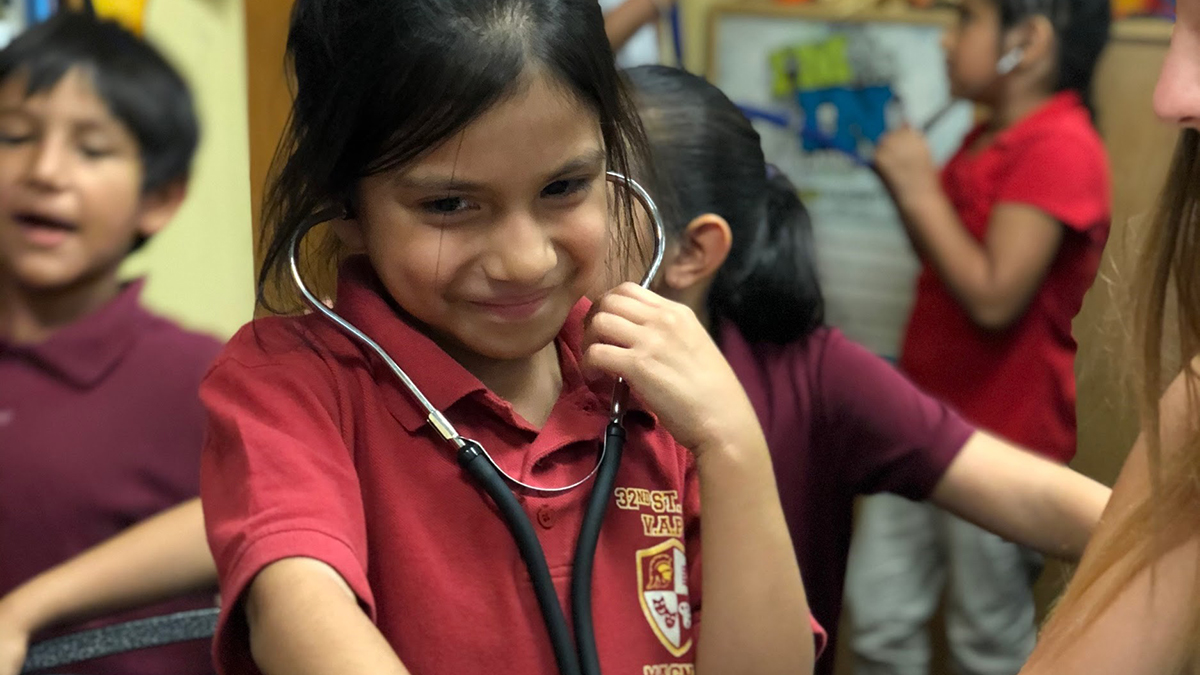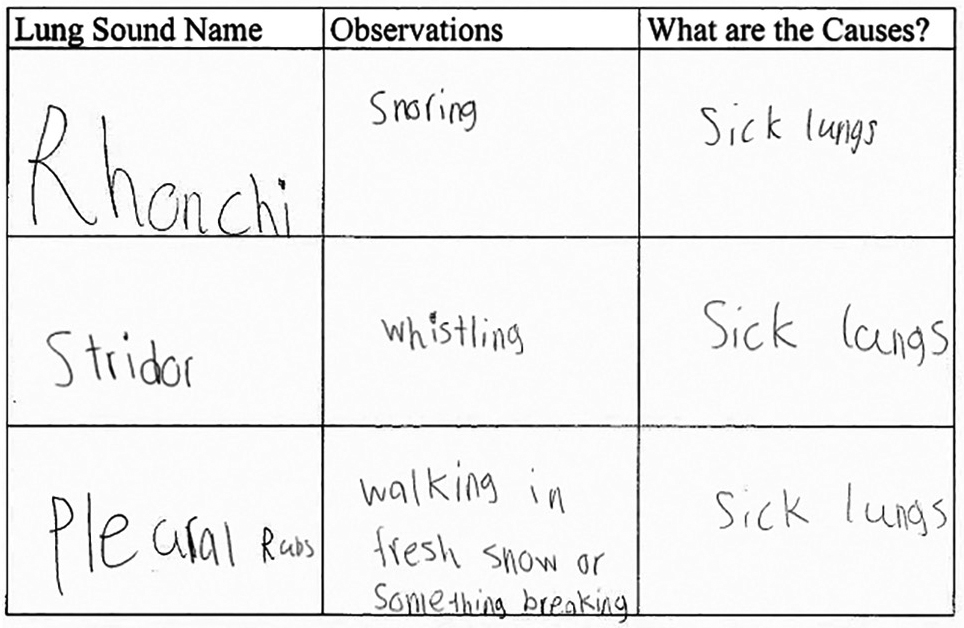feature
Diagnostics Through Sound
A module for introducing students to lung disease and pulmonology
Science and Children—May/June 2022 (Volume 59, Issue 5)
By Dieuwertje J. Kast, Surbhi Bansil, and W. Martin Kast

According to the American Cancer Society, lung cancer (i.e. including both small cell and non-small cell lung cancer) is the second most common cancer diagnosis and is the leading cause of cancer-related death in the United States for both men and women. The etiologies of many different types of lung cancer can be linked to risk factors that can be prevented, such as chronic tobacco smoking. Lung cancer is significantly more prevalent among socioeconomically disadvantaged and minority populations. Due to the significance of lung cancer as a public health issue, we have developed a module on the topic of pulmonology—a medical specialty field that deals with disease processes involving the respiratory system—to (1) explain the basics of normal lung physiology, (2) explain the pathological changes associated with lung cancer and other lung diseases, (3) provide preventive education on the importance of tobacco abstinence and the damaging effects of tobacco smoking on the lungs, and (4) introduce students to some pulmonologic interventions.
Implemented through JEP’s Wonderkids Program, this Cancer Education Initiative Program is targeted toward first- through third-grade students from underrepresented minorities of the Los Angeles Unified School District (LAUSD) and aims to address students’ misconceptions and lack of knowledge regarding the pathogenesis, diagnosis, and treatment of cancer; provide preventive health promotion education so that students may make more healthy lifestyle choices, and foster students’ interests in STEM and health care fields.
Project Background
The University of Southern California (USC) has several service learning programs that address disparities in science education within the neighboring Los Angeles community. In the spring of 2018, a Cancer Education Initiative Program was launched through a partnership between the USC/Norris Comprehensive Cancer Center, the USC Rossier School of Education, and the USC Dornsife School of Letters Arts and Sciences’ Joint Educational Project (JEP) (Kast, Singh, and Kast 2018).
In compliance with the Next Generation Science Standards (NGSS), a cancer education curriculum was developed and implemented featuring lessons based in science, technology, engineering, and math (STEM) concepts in relation to cancer. The lesson plans and activities align with grades 3–5 NGSS standards; however, they were implemented with students of grades 1–3 (see Online Resources for the complete module). Classes are facilitated at local public elementary schools by undergraduate students. Our standard lesson plan format includes a general lesson to explain pertinent background information followed by a supplementary activity or experiment to effectively reinforce the concepts being taught. Each semester, students are taught lessons based on overarching module topics. The USC/Norris Comprehensive Cancer Center has provided funding for the program’s curriculum development, student educators, and materials.
Lung Sounds Lesson Plan
The lung sounds lesson plan aims to introduce students to different lung sounds, which are clinical indicators for different respiratory diseases, including lung cancer. Students were first introduced to the importance of lung auscultation (listening to the lungs) as one of health providers’ tools for making diagnoses and clinical judgements. It was explained that depending on any underlying respiratory diseases, the normal sounds of the lungs may change. Students were then presented with their own stethoscopes and a cardboard human torso model (see Figure 1).

Students interact with the lung sound model.
The activity was designed to incorporate inexpensive alternative materials that are readily available and significantly more affordable than products typically used for medical education, yet still able to simulate the effects of these more expensive products. The human torso model was crafted in reference to manikin models that are typically used to educate students in the health professions. The cardboard model featured an outer layer that students could remove to reveal the location of the lungs in the body (See Online Resources for how to construct this). Affordable stethoscopes (each under $10) were purchased online and used by the students to auscultate lung sounds in the activity.
Diversity of learning needs and multiculturalism were accounted for in the design and implementation of this lesson plan to allow for multisensory three-dimensional learning. Examples include the use of a tactile cardboard human patient model of a person of color, and the incorporation of audible lung sounds via tape recorders, which the students were able to listen to with stethoscopes.
Within the model, a recorder device containing prerecorded lung sounds was fastened. Students were then able to use their stethoscopes to “listen” to this cardboard human patient’s lungs and how these lung sounds change in relation to different respiratory pathologies. Lung sounds that were included were normal (vesicular) breath sounds, crackles (rales), wheezing, rhonchi, stridor, and pleural rubs; all of these lung sounds were accessed online from Basics of Lung Sounds, a free website utilized for medical education, and recorded onto the recorder device (see Online Resources).
Lung sounds were chosen to demonstrate differences between “healthy” and “sick” lung sounds to the students. “Healthy” lung sounds were demonstrated with the normal (vesicular) breath sounds, which are soft and low in pitch. “Sick” lung sounds were demonstrated with crackles (rales), wheezing, rhonchi, stridor and pleural rubs. Crackles (rales) are brief, discontinuous, popping lung sounds that are high in pitch, analogous to the sound of television static for example; crackles are typically associated with diseases such as pneumonia or heart failure. Wheezing is a continuous, “musical” lung sound which can range from low pitched “moaning or snoring” to high pitched “squeaking”; Wheezing is typically associated with diseases such as asthma, lung cancer, or chronic obstructive pulmonary disease (COPD). Rhonchi are continuous, low pitched, “gurgling” lung sounds, typically associated with diseases such as cystic fibrosis, pneumonia, and COPD. Stridor are high-pitched whistling sounds typically associated with lung cancer or croup. Finally, pleural rubs are creaking or grating lung sounds analogous to the sound of walking on fresh snow; these sounds are associated with pneumonia, pleurisy, and pulmonary embolism. These abnormal lung sounds appear in diseased lungs of various aforementioned respiratory system pathologies, which often result secondary to chronic smoking or second-hand exposure to tobacco smoke (Groot, et al. 2018). Allowing students to listen to both “healthy” and “sick” lung sounds helped to elucidate the dangers of smoking and how tobacco exposure can alter the normal traits and functioning of the lungs.
Within the classroom, students shared cardboard human patient models and stethoscopes as they completed the activity. For safety and sanitation purposes, alcohol-based disinfectant wipes were provided so that students could share stethoscopes. As they listened to the different lung sounds, each student was provided their own worksheet to individually record their observations and make conclusions on what they believed the lung sounds may indicate (i.e “healthy” vs. “sick” lungs) (see Figure 2).

Student work sample of the lung sound worksheet.
After each student was able to auscultate the different lung sounds and complete their worksheet individually, students re-grouped as a class to share their observations and conclusions, first in pairs and finally together as a class.
Beyond Sound
There are three other lessons included within this pulmonology module (see Online Resources). The first is a lung anatomy and physiology lesson, in which students constructed a lung model using a water bottle, balloons, straws, and modeling clay. This model provides a visual simulation of the physiological changes of the lungs and diaphragm during normal respiration.
The second is a lung cancer lesson that aims to introduce students to the causes and effects of lung cancer, as well as to provide prevention education on the risks of smoking as a contributor to the development and progression of lung cancer. Students played several games to learn about the short-term and long-term effects of smoking on the body, particularly the lungs. For the main activity, students used 3D-printed lung anatomy “cookie cutters” to create molds of lungs in pink, brown, and black modeling clay to provide visual representations of the progressive damaging effects of chronic smoking on the lungs.
The third is a trachie buddies lesson that introduced students to the tracheostomy and breathing tube placement procedure, which is a procedure in which an assistive breathing device is placed in the trachea of patients with severe chronic respiratory diseases. Students made their own “trachie buddies,” which are stuffed animals to which they applied 3D-printed breathing tubes. This lesson was incorporated to help introduce, familiarize, and normalize an example of an assistive medical device to the young students.
Conclusion
To generally gauge and assess students’ learning, pre- and posttests were given to the students at the beginning and end of the pulmonology module. Students were asked to draw a picture and write a sentence in response to the question “What is a Pulmonologist?” (see Figure 3).

Student work example of the posttest, “What is a pulmonologist?”
At the beginning of the module, 24% of students provided responses that demonstrated they had some preexisting knowledge of what a pulmonologist is. At the end of the module, approximately 62% of students demonstrated that they have an understanding of what a pulmonologist is. Posttests reflected learning outcomes particularly aligned with second-grade NGSS standards that were considered in the development of the curriculum. For instance, students demonstrated their understanding that the cardboard human torso was a model constructed to mimic a real human body and that auscultating this model simulated how a real physician would listen to the lung sounds of an actual patient. Additionally, students were able to use the observations they made while auscultating the different lung sounds to make conclusions as to whether each lung sound was made by “healthy lungs” or “sick lungs.” Overall, students seemed to show a general increase in their knowledge and grasp of pulmonology concepts.
Moving forward, the program hopes to continue to utilize an NGSS-aligned curriculum that successfully addresses students’ misconceptions and lack of knowledge about cancer, provides important health promotion education, and cultivates students’ interests in STEM and healthcare fields. We hope that other elementary school teachers will utilize or adapt our lesson plans in their classrooms so that they can achieve similar goals. ●
Acknowledgments
The development and execution of this lung disease lesson plan was made possible through funding from the USC/Norris Comprehensive Cancer Center NIH 5 P30 CA 014089 grant. W. Martin Kast holds the Walter A. Richter cancer research chair. The Joint Educational Project’s Wonderkids Program through Readersplus+ provided the infrastructure and students for the execution of this pulmonology unit at two schools (Vermont Avenue Elementary and 32nd Street Performing Arts Magnet).
Online Resources
Basics of Lung Sounds: https://www.easyauscultation.com/course-contents?courseid=201
Pulmonology Module: https://docs.google.com/document/d/1rKAklBJeSinjVseh0UgznBIGSaMSh5bs1JxvD2CMoPg/edit
Dieuwertje J. Kast* (dkast@usc.edu) is the director of STEM education programs at the University of Southern California’s Joint Educational Project in Los Angeles, California. Surbhi Bansil* was curriculum writer for the University of Southern California’s Joint Educational Project in Los Angeles, California. W. Martin Kast is a director of the K–12 Cancer STEM education program and a professor of molecular microbiology and immunology at University of Southern California’s USC/Norris Comprehensive Cancer Center in Los Angeles, California.
*These authors contributed equally.
Biology Physical Science Teaching Strategies Elementary


